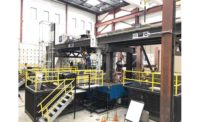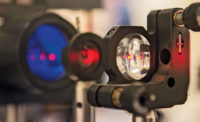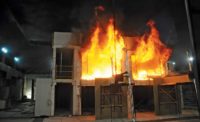A recent series of dynamic tests demonstrates that there are several types and doses of steel-fiber reinforcement that can be used in performance-based seismic design of coupling beams—headers that link openings in concrete shear walls—to reduce rebar congestion. The tests, performed at the University of Wisconsin, are called “a step in the right direction” by the structural engineer who pioneered the use of SFR concrete.
“The results show a way forward for the development of a performance-based specification for steel fiber, as opposed to a product-based spec,” says Cary Kopczynski, CEO of the firm that bears his name. “This will open up the competitive marketplace, which is key to the wider use of SFR concrete in tall buildings.”
In earthquake-prone areas, rebar congestion, especially heavy transverse and diagonal bars in coupling beams, has long bedeviled contractors. Mixing in SFR at the batch plant enhances ductility and shear strength, reducing rebar needs. That can increase constructibility and material performance, says Kopczynski.
Earlier material research was limited to one dose of fiber from one supplier. In the tests at the Wisconsin Structures and Materials Testing Laboratory, Madison, investigators subjected eight fiber-reinforced concrete coupling beams, without diagonal reinforcement, to large displacement reversals. They conducted bending tests, direct tension tests and compression tests, using different fiber doses and strengths. Wire suppliers Bekaert Corp. and ArcelorMittal provided the fibers.
“Based on the results from this research and those reported elsewhere, recommendations are given that tie material performance with coupling-beam drift and expected shear stress demand so that a simplified reinforcement detailing can be used as an alternative to the current diagonally reinforced coupling-beam design specified in the 2014 American Concrete Institute Building Code,” says the report, “Evaluation of Seismic Behavior of Coupling Beams With Various Types of Steel Fiber Reinforced Concrete,” written by Angel L. Perez-Irizzary and Gustavo J. Parra-Montesinos and published this month by the research’s main sponsor, the Charles Pankow Foundation.
Pankow and other sponsors, includding Bekaert, the ACI Concrete Research Council and the American Society of Concrete Contractors, provided a $214,240 grant for the research.
Each specimen consisted of a precast, rectilinear coupling beam, in a vertical position, connected to two large rectilinear blocks that simulated end regions of two linked walls. The main variables investigated were span-to-depth ratio and peak shear stress demand. The tests showed that several alternative fibers can be used in beams and still achieve the main goal of eliminating diagonal reinforcing bars and reducing transverse rebar, says Parra-Montesinos, the tests’ principal investigator and a Wisconsin professor of engineering.
Satisfactory performance can be achieved with volume fractions—the ratio of fiber to concrete—of 1% and 1.25%, as opposed to the denser 1.5%, which Kopczynski specified for recent high-rise projects in Seattle and Bellevue, Wash.(ENR 9/26-10/3 p. 30). “This may lead to mixes that are pumpable, eliminating the need for bucketing,” says Kopczynski.
Parra-Montesinos adds, “I’m optimistic that, given the advantages of simplified reinforcement and with [more contractor] field experience, designers will use coupling beams more and more.”







Post a comment to this article
Report Abusive Comment